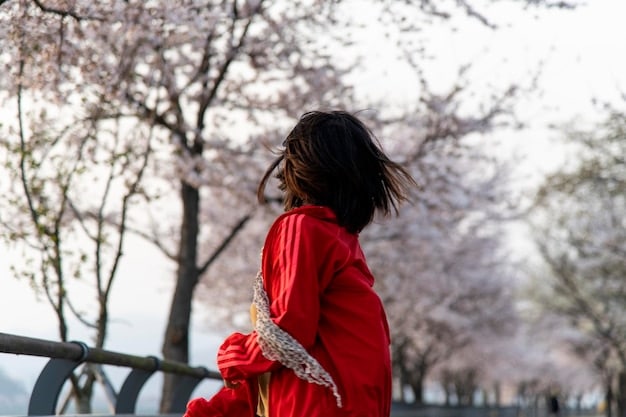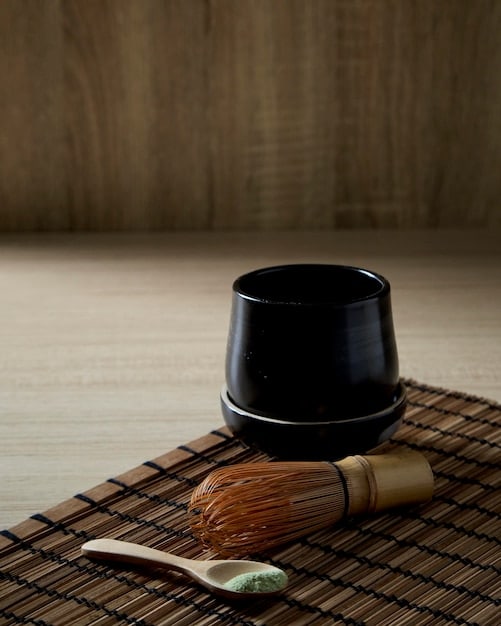Japan’s Etiquette Essentials: A US Traveler’s Guide for 2025

Japan’s Etiquette Essentials: A US Traveler’s Guide to Avoiding Cultural Missteps in 2025 offers crucial insights into Japanese customs, from bowing and dining etiquette to navigating public spaces, ensuring a respectful and enriching travel experience for Americans.
Planning a trip to Japan in 2025? Understanding and respecting local customs is key to a smooth and enjoyable experience. This guide, Japan’s Etiquette Essentials: A US Traveler’s Guide to Avoiding Cultural Missteps in 2025, highlights essential etiquette tips for American travelers.
Understanding Japanese Bowing Customs
Bowing is a fundamental aspect of Japanese culture, expressing respect, gratitude, and apologies. For US travelers, mastering the art of bowing can significantly enhance interactions and demonstrate cultural sensitivity.
Types of Bows
Different situations call for different types of bows. Learning to distinguish between them can prevent awkward encounters.
- Eshaku (会釈): A slight 15-degree bow, used for casual greetings or when passing colleagues in a hallway.
- Keirei (敬礼): A 30-degree bow, showing respect to superiors or during formal situations.
- Saikeirei (最敬礼): A deeper 45-degree bow, expressing sincere apologies or deep gratitude.
Remember that the depth of the bow usually indicates the level of respect or apology.
When to Bow
Bowing isn’t just for greetings. It’s used in various scenarios, demonstrating respect and acknowledging socialHierarchy.
- When greeting someone.
- When thanking someone for a gift or service.
- When apologizing for a mistake.
- When departing from someone.
Observing how locals bow in different situations is a great way to learn and adapt.
Bowing is a display of respect. Remember that the depth and duration of the bow convey your level of sincerity and respect. As you end your bow, slowly return to an upright position.

Navigating Dining Etiquette in Japan
Japanese dining etiquette can seem daunting, but understanding the basics will help you enjoy the culinary experience while showing respect for tradition.
Chopstick Etiquette
Using chopsticks correctly is crucial to avoid appearing rude or disrespectful.
- Do not stick chopsticks vertically into rice, as it resembles incense offerings for the deceased.
- Do not pass food directly from chopstick to chopstick, as this is part of funeral rituals.
- Do not use chopsticks to move dishes around.
- Do not leave chopsticks lying across the bowl; use the chopstick rest provided.
Handling chopsticks with care and awareness demonstrates respect for Japanese dining customs.
Table Manners
Beyond chopsticks, other table manners are equally important.
Slurping noodles is acceptable and even appreciated, as it indicates enjoyment. Finish all the rice in your bowl; it is considered wasteful to leave any behind. Saying “gochisousama deshita” (thank you for the meal) after eating is a polite gesture.
Understanding and following these dining etiquette tips will greatly enhance your experience in japan. Try to observe what others are doing and learn from them.
Understanding the Concept of “Omotenashi”
Omotenashi is the Japanese concept of selfless hospitality. Understanding this concept will significantly enhance your experience as a traveler.
What is Omotenashi?
Omotenashi goes beyond simple customer service; it’s anticipating and fulfilling guests’ needs before they even arise.
It is rooted in mindfulness and empathy, creating an environment where guests feel truly cared for. In Japan, you’ll frequently encounter omotenashi in hotels, restaurants, and shops.
How to Show Appreciation
While tips are generally not accepted in Japan, there are other ways to show your gratitude.
- Express sincere gratitude with words like “arigato gozaimasu” (thank you very much).
- Offer a small gift when appropriate, such as a souvenir from your home country.
- Show respect for the service by being punctual and attentive.
Recognizing and appreciating omotenashi will deepen your connection with Japanese culture.
Be mindful of the extra care and attention you receive, and reciprocate with respect and gratitude can go a long way. Omotenashi is about creating a memorable experience for the guest.

Navigating Public Transportation with Grace
Japanese public transportation is efficient and punctual, but it also comes with its own set of etiquette rules.
Quiet on Trains
Maintaining a quiet environment on trains is crucial.
Avoid loud conversations, phone calls, and playing music without headphones. Set your phone to silent mode and refrain from talking as much as possible. Being considerate of other passengers contributes to a pleasant travel experience for everyone.
Priority Seating
Priority seating is reserved for the elderly, pregnant women, and those with disabilities. Be aware of these seats and offer them to those in need.
Even if the seats appear empty, someone might need them more than you. Watch out for signs indicating priority seating and be prepared to offer your seat.
By respecting these simple rules, you can contribute to a comfortable and harmonious travel experience for all passengers. Understanding these rules can help foreigners feel more confident when taking the train.
Respecting Onsen (Hot Spring) Etiquette
Onsen, or hot springs, are an integral part of Japanese culture, offering relaxation and rejuvenation. Keep in mind that there are rules to follow.
Hygiene is Key
Before entering the onsen, thoroughly wash and rinse your body at the provided washing stations.
This ensures that everyone enters the bath clean and helps maintain the hygiene of the water. Use the provided soap and shampoo, and thoroughly rinse off all soap before entering the onsen.
No Swimsuits
Onsen are typically enjoyed in the nude. Swimsuits are generally not allowed, except in certain mixed-gender onsen where they might be required or permitted.
If you are uncomfortable with nudity, consider visiting a private onsen or a mixed-gender onsen that allows swimsuits. Confirm the dress code with the onsen beforehand.
Following these guidelines ensures a pleasant and respectful onsen experience for all. Remember to enjoy the relaxing benefits of the hot springs.
Gift-Giving Customs to Keep in Mind
Gift-giving is an important aspect of Japanese culture, with its own set of customs and traditions.
Presentation Matters
The way you present a gift is as important as the gift itself.
Wrap gifts neatly and elegantly, using high-quality wrapping paper. Use both hands when offering and receiving gifts. A simple “this is just a small token” can accompany the presentation.
What to Give
When choosing a gift, consider items that are unique to your home country or region.
- Local food and snacks.
- Handicrafts or artisanal products.
- Souvenirs that represent your culture or city.
Avoid giving gifts in sets of four, as the number four is associated with death in Japanese culture.
Understanding these gift-giving protocols will ensure that your gesture is well-received. Keep in mind you gift should be both meaningful and considerate.
| Key Point | Brief Description |
|---|---|
| 🙏 Bowing | Express respect and gratitude with appropriate bows. |
| 🍜 Dining | Understand chopstick etiquette and table manners. |
| 🚃 Transportation | Maintain quiet and respect priority seating. |
| 🎁 Gift Giving | Present gifts thoughtfully and avoid unlucky numbers. |
Frequently Asked Questions (FAQ)
▼
No, tipping is generally not expected and can even be considered rude in many situations. Instead, focus on expressing your gratitude verbally and respecting the service provided.
▼
A bow is the most common and respectful way to greet someone. The depth of the bow indicates the level of respect. A slight nod is generally appropriate for casual situations.
▼
While attitudes are changing, tattoos are still often associated with organized crime. It’s best to cover them up when visiting temples, gyms, or onsen, where they may not be allowed.
▼
Business cards (meishi) should be exchanged with both hands, with the card facing the recipient. Receive the card with respect, read it carefully, and avoid immediately putting it away. It shows respect and professionalism.
▼
Learning a few basic Japanese phrases can go a long way. Additionally, carrying a translation app or phrasebook can be extremely helpful. Many Japanese people also appreciate your effort to communicate.
Conclusion
By understanding and practicing these etiquette essentials, US travelers can navigate Japan with grace and respect, fostering meaningful cultural exchanges and creating unforgettable travel experiences. Remember that being mindful and respectful will greatly enhance your trip.





